The fourth purpose of the Recovery Version with the footnotes is to open up the books of the Bible. Witness Lee states that in writing the footnotes of the New Testament, he has attempted to “open every book.” While the outline of a book of the Bible gives a “bird’s-eye view” of an entire book, certain key footnotes, especially those found at the beginning of a book, help open the book to the reader. Witness Lee considered that the book of Revelation was no longer a “closed book” but an “open book” due to the Recovery Version of Revelation, which “gives you a very brief and concise interpretation of the book” (Elders’ Training, Book 3: The Way to Carry Out the Vision, ch. 9 [CWWL, 1984, 2:311).
In the book of Revelation there are two key footnotes at the beginning of the book that open up the book to us. The first footnote mentions the place of Revelation at the end of the Bible and its function to indicate the consummation of all the seeds in the Bible.
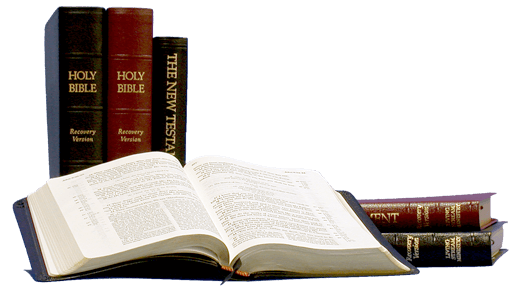
As the last book of the Bible, Revelation is the conclusion, completion, and consummation of the entire divine revelation, the whole Bible. The seeds of most of the truths of the divine revelation were sown in Genesis, the first book of the Bible. The growth of all these seeds is progressively developed in the succeeding books, especially in the books of the New Testament, and the harvest is reaped in the book of Revelation. Hence, most of the things covered in this book are not absolutely new but are in the preceding books and are perfected in this book, the focus of which is the unique, ultimate revelation of Christ, the particular, consummate testimony of Jesus, and the universal, eternal economy of God. (Rev. 1:1, footnote 1)
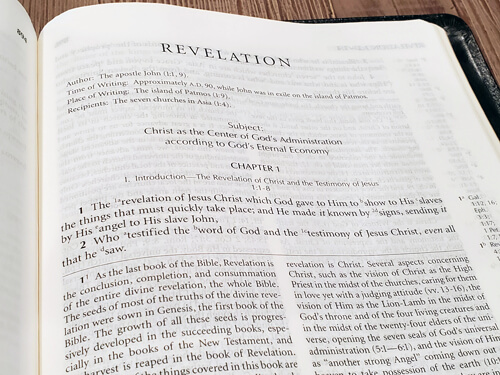
The note continues to explain the significance of the book’s title: this book is the revelation of Jesus Christ, who is the focus of all that is revealed in Revelation. In addition to many aspects of Christ revealed in Revelation that are based on revelations in the preceding books of the Bible, Christ is also unveiled in a new way
as the High Priest in the midst of the churches, caring for them in love yet with a judging attitude ([1:]13-16),…as the Lion-Lamb in the midst of God’s throne and of the four living creatures and in the midst of the twenty-four elders of the universe, opening the seven seals of God's universal administration (5:1—6:1), and…as “another strong Angel” coming down out of heaven to take possession of the earth (10:1-8; 18:1). (Rev. 1:1, footnote 1)
Another footnote shows the development of another crucial revelation, the church as the testimony of Jesus in Revelation.
On one hand, this book gives us the revelation of Christ, and on the other hand, it shows us the testimony of Jesus, which is the church. It presents to us the revealed Christ and the testifying church. The lampstands in ch. 1, the great multitude of the redeemed in ch. 7, the bright woman with her man-child in ch. 12, the harvest with its firstfruits in ch. 14, the overcomers on the sea of glass in ch. 15, the bride ready for marriage in ch. 19, and the New Jerusalem in chs. 21 and 22 are all the testimony of Jesus. (Rev. 1:2, footnote 1)
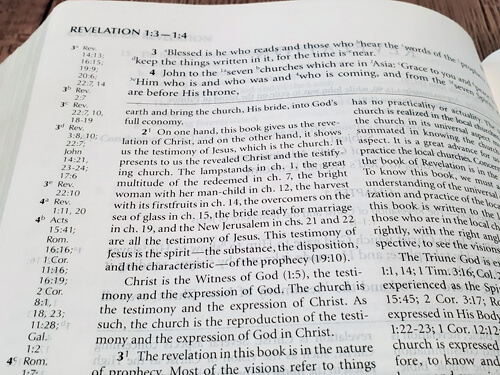
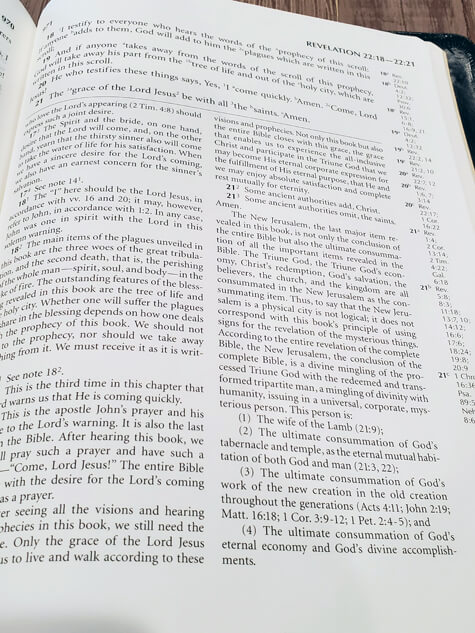
Witness Lee also stated that while his opening of a book of the Bible has “opened up the mine,” he has left the “further digging” to the readers. (Elders’ Training, Book 3: The Way to Carry Out the Vision, ch. 9 [CWWL, 1984, 2:311]). The last footnote of Revelation is also instructive and illustrates the matter of opening a mine for further digging.
The New Jerusalem, the last major item revealed in this book, is not only the conclusion of the entire Bible but also the ultimate consummation of all the important items revealed in the Bible. The Triune God, the Triune God's economy, Christ’s redemption, God’s salvation, the believers, the church, and the kingdom are all consummated in the New Jerusalem as the consummating item….The New Jerusalem, the conclusion of the complete Bible, is a divine mingling of the processed Triune God with the redeemed and transformed tripartite man, a mingling of divinity with humanity, issuing in a universal, corporate, mysterious person. This person is: (1)The wife of the Lamb (21:9); (2)The ultimate consummation of God’s tabernacle and temple, as the eternal mutual habitation of both God and man (21:3, 22); (3)The ultimate consummation of God’s work of the new creation in the old creation throughout the generations (Acts 4:11; John 2:19; Matt. 16:18; 1 Cor. 3:9-12; 1 Pet. 2:4-5); and (4)The ultimate consummation of God's eternal economy and God's divine accomplishments. (Rev. 22:21, footnote 3)
This note opens up the mine and encourages the reader to dig in the text, other footnotes, and other publications to search and confirm the validity that the New Jerusalem is the ultimate consummation of the Triune God, the Triune God’s economy, Christ’s redemption, God’s salvation, the believers, the church, and the kingdom. Through this digging the reader can also discover how the New Jerusalem is the greatest and ultimate sign in the Bible. Although the New Jerusalem is briefly presented in less than two chapters of the Bible, its rich symbolism consummates so many crucial and rich items. Indeed, its all-inclusive design comes uniquely from God, the prototypical “Architect” in the universe (Heb. 11:10).
When we turn to the first footnote in the first book of the Bible, we see that this note opens up not only Genesis but also the entire Bible:
The Bible, composed of two testaments, the Old Testament and the New Testament, is the complete written divine revelation of God to man. The major revelation in the entire Bible is the unique divine economy of the unique Triune God (Eph. 1:10; 3:9; 1 Tim. 1:4b). The centrality and universality of this divine economy is the all-inclusive and unsearchably rich Christ as the embodiment and expression of the Triune God (Col. 2:9; 1:15-19; John 1:18). The goal of the divine economy is the church as the Body, the fullness, the expression, of Christ (Eph. 1:22b-23; 3:8-11), which will consummate in the New Jerusalem as the union, mingling, and incorporation of the processed and consummated Triune God and His redeemed, regenerated, transformed, and glorified tripartite people. (Gen. 1:1, footnote 1)
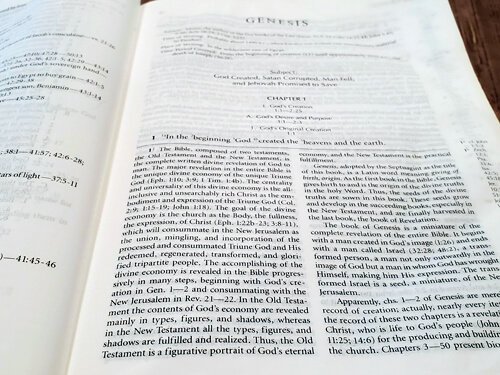

The note continues by connecting the name Genesis, meaning giving of birth, origin, to its function as a book of the seeds of the divine truths that grow and develop in succeeding books, until they are finally harvested in the last book, Revelation.
Genesis also is a miniature of the history of the experience of humankind, beginning from the creation of man in God’s image (1:26) and consummating in the transformation of Israel as God’s expression, as a seed or a miniature of the New Jerusalem (48:2)
Finally, the note prepares us for the revelation of Christ as life to God’s people seen in chapters 1—2 for the producing and building up of the church, and the biographies of eight great persons “representing two races of men: Adam, Abel, Enoch, and Noah, representing the created race, and Abraham, Isaac, Jacob, and Joseph, representing the called race” with “their life, their living, and their way with God.”
Readers of the Recovery Version will find that each book usually has one or more crucial footnotes that open the book. With the help of these footnotes they will be able to focus on the most crucial and intrinsic matters contained in each book so that they may be enlightened in their understanding and brought into the experience of what they read.

Living Stream Ministry now has an app for the Recovery Version. View more details about this app or download it from one of the app stores below:
eBooks Available for Purchase:
Print Editions Available for Purchase: